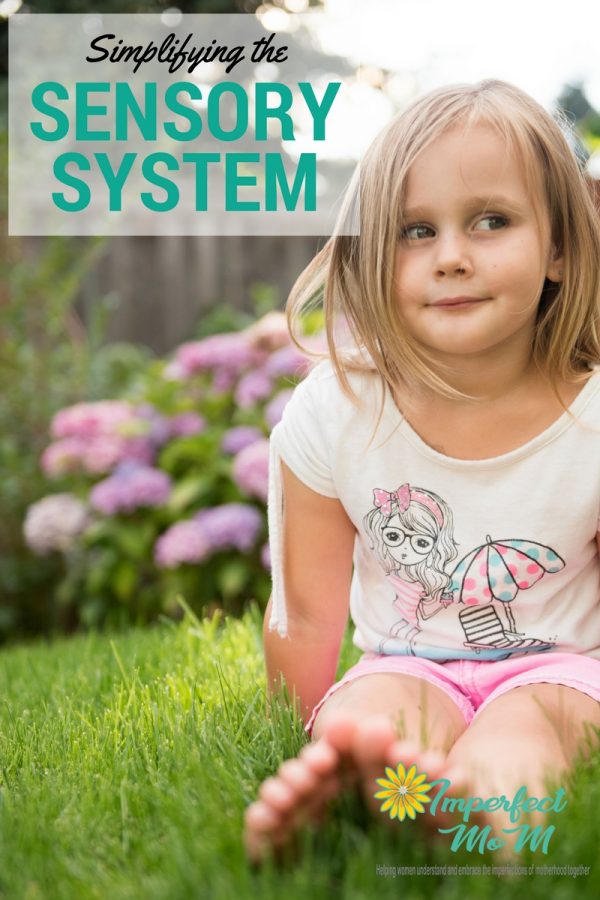Simplifying the Sensory System
When I first heard of the sensory system I was about 6 years old and in kindergarten.
I was told about my ears, nose, mouth, eyes, and hands and how those made up my 5 senses.
As an adult I heard words like sensory processing, sensory activities, sensory diet, and so many more.
After being lost in the confusion of all the words, I dedicated a few years to studying all I could about the sensory system and finding a way to truly make sense of it all.
I knew every living person has a sensory system, and figured we all need to understand it a bit more to make sense of the world around us.
For the most part, we don’t pay much attention to the importance of this system when it works well and allows people to function in a typical manner.
When that doesn’t happen, things like tantrums, poor focus, short attention span, delayed speech, and many other tendencies seem puzzling and unexplained.
In my own life, I’ve found that a solid understanding of the sensory system is the key to understanding all other aspects of life.
It explains behavior, it helps me know how to address it, and shows me where I need to make changes in our daily lives.
It all comes back to sensory.
There is SO much to it that I never knew.
My goal is to help you see the sensory system as the amazing and important thing in the most simple way, as if we were all relearning about it in kindergarten.

What is the Sensory System?
The sensory system is what helps a person experience and process the information around them at any given moment in time.
For this reason, sometimes you’ll hear people referring to it as “sensory processing” which simply refers to the way the body interprets stimulation.
Things like the brightness of the sun, the noise level in a room, the amount of force to use when shutting a door, and how to stay balanced when walking up the stairs are all possible because of a properly functioning sensory system.
Our bodies actually have 7 sensory systems.
The two you may not have heard of are the proprioceptive, and vestibular senses.
Those are big words and are not nearly as easy to remember as the other 5, with a little explanation, these two senses will likely open your eyes to SO many “mysteries” about your child that were previously unexplained.
To keep it basic, the seven senses cover the following things:
- Vision– all things pertaining to sight (colors, light, etc.)
- Hearing or auditory– all things pertaining to hearing (volume, noise, amount of sound, etc.)
- Smell or olfactory– all things pertaining to smell
- Taste or oral– all things pertaining to the way things taste
- Touch or tactile– all things dealing with how things feel on any part of the body (mouth, hands, feet, head, etc.)
- Proprioception– all things dealing with the position of the body in space, anything dealing with pressure, and movement.
- Vestibular– all things dealing with balance, gravity, and head movement.
Proprioception and vestibular likely still seem a bit confusing, and that is ok.
Right now, let’s look at the whole sensory system to find out how all seven senses work together and what happens when it doesn’t work.
Sensory Cups
To describe the sensory system, I like to use the analogy of cups.
Each person has a set of “sensory cups” that are always fluctuating in size and fullness (is that a word?).
Each cup represents one of the seven senses; see, hear, smell, touch, taste, feel, proprioception, vestibular.
The size of the sensory cup in each person is different.
This means that while some people can tolerate a lot of one type of stimulation, others might only be able to tolerate a little.
For instance, I have a bigger visual cup than my son whose cup seems to be very small which causes him to squint any time he is in the sun.
My husband has a bigger tactile cup and tolerates touch more than I can.
Those people with bigger cups are those who need more sensory stimulation to feel right inside.
These people are often referred to as “sensory seekers.”
Those with smaller cups will become easily stressed out, frustrated, irritated, or can even feel physical pain with even a little stimulation to that particular sense.
These people are referred to as “sensory avoiders” because they are typically trying to avoid any stimulation that would cause their sensory cup to overflow.
Being able to detect when a person has a big cup or small cup is fairly easy.
When one particular stimulation causes a person stress, discomfort, or irritation, we know that particular cup is full therefore the child AVOIDS it.
On the other hand, if a person is feeling like they need more of something; more movement, more music, or a more spicy taste in the food they eat, it is a sign of the cup for a particular sense being too empty and needing to be filled, therefore they SEEK it.
Sensory Behavior
Most of us have learned how to appease our sensory preferences.
We likely avoid certain sounds, smells, lights, or situations because those cause us stress.
That is a learned behavior in response to a sensory aversion.
On the other hand, we likely seek out certain feelings, sounds, motions, and situations subconsciously, but we do so because we’ve learned that our sensory systems need those things.
As we said before, behavior is a form of communication.
Most often, behavior is the way for the body to communicate that something in the sensory system is off.
Is the child seeking attention?
YES!
Because they don’t know how to say “my sensory system is off, I need help!”
Is the child avoiding certain things?
YES!
Again, because their sensory system says they need to.
Are they trying to gain access to things?
YES!
Because the sensory system tells them to.
Do you see the pattern?
Is it behavior?
Yes!
Is it rooted in sensory?
YES!
So let’s not worry too much about separating the two.
A person who spends too much time trying to avoid or seek out sensory stimulation ends up living in a very unpredictable, uncomfortable, and frightening world.
Without a knowledge of which sensations are going to throw their body into fight or flight mode, and without the support of an adult who understands, the child is forced to put up walls to try to protect themselves all the time.
This child is the one who seems defiant around specific situations.
It is the one who seems manipulative and always wants to be the one to make decisions.
It is the “strong willed” child who has to be the boss all the time.
This is the child who is labeled “bad,” but in reality, he is only trying to protect his sensory system.
So, when talking about sensory being a function of behavior, it truly is so much more than most people realize.
A regulated sensory system can do more to change behavior than all the timeouts or discipline in the world.
Putting It All Together
So while there is much more to the sensory system than we were ever told in our early years, understanding it doesn’t have to be complicated.
In fact, understanding the sensory system is what has helped hundreds of readers feel relieved to know what is causing the behaviors, tendencies, preferences, and reactions their kids have on a daily basis.
While our elementary knowledge of the 5 senses was fun to help us explore the world around us on a deeper level, taking it a step further is the key to exploring your child’s world on a deeper level.
For further reading about Sensory Processing Disorder:
The Out-of-Sync Child: Recognizing and Coping with Sensory Processing Differences Raising a Sensory Smart Child: The Definitive Handbook for Helping Your Child with Sensory Processing Issues
Raising a Sensory Smart Child: The Definitive Handbook for Helping Your Child with Sensory Processing Issues Understanding Your Child’s Sensory Signals: A Practical Daily Use Handbook for Parents and Teachers
Understanding Your Child’s Sensory Signals: A Practical Daily Use Handbook for Parents and Teachers The Out-of-Sync Child Has Fun, Revised Edition: Activities for Kids with Sensory Processing Disorder
The Out-of-Sync Child Has Fun, Revised Edition: Activities for Kids with Sensory Processing Disorder
About the Guest Author
This post originally appeared on WendyBertagnole.com and is reprinted with permission.
With an undergraduate degree in child development, and a master’s degree in special education, this foundation was a springboard for Wendy in helping kids and families to see the root of any challenges they face.




